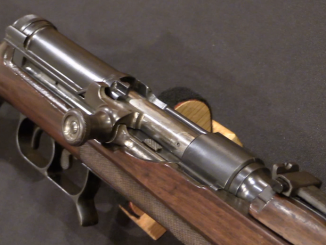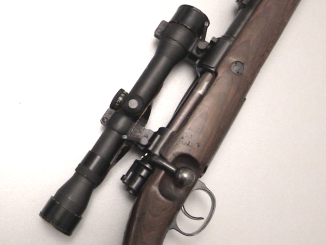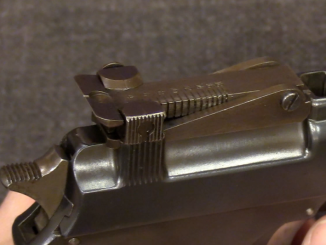Josef Schulhof was an Austrian who decided to leave his farm and work in firearms design. He moved to Vienna and received his first firearms patent in 1882. He would go on to design and manufacture a small line of manual repeating handguns through the mid and late 1880s, until his death in 1890. This particular example is an 1884 model, type IIa. It uses a toggle lock much like the Winchester series of rifles, and a tubular magazine which runs down into the grip and is loaded via a gate under the chamber. The “II” refers to Schulhof’s design improvement of making the actual trigger a separate part from the ring trigger (on the type I they were integrated together). This allowed for a more controlled trigger press, and better practical accuracy. About 50 of these 1884 pattern guns were made, and they include several different type of magazine, including a rotary magazine on at least one example and an en bloc clip on at least one other.
Needless to say, these pistols failed to spark any serious military interest, and were also never produced in series for the commercial market. Still, they remain an important link in the development of self-loading handguns.




“tubular magazine which runs down into the grip”
This reminded me about Clair Automatic Pistol: https://www.forgottenweapons.com/clair-automatic-pistol/
Really neat design.
He could have scaled it up to carbine size, maybe with a longer magazine, and sold it to the Austrian cavalry. Any idea what caliber?
The Schulhof bolt-action rifle of 1887 used a variant of this action, complete to the tubular magazine, which fed from a three-column gravity-feed “box” in the stock, loaded down through a metal flap in the comb. Total capacity was about 22 rounds, and the patent drawing (found on p. 77 of the 10th edition of Small Arms of the World) appears to show it chambered for 11.4 x 50R Werndl M1873, which was still in use by the Austrian Army at the time.
The Austrian Army took a long look at it, and instead adopted the Mannlicher Model 1888 in 8 x 50R.
cheers
eon
“22 rounds”
В.Е. Маркевич (Ручное огнестрельное оружие) says that Schulhof rifle pattern 1880-1881 has capacity of 28 “powerful combat cartridges” but do NOT states directly that they were default Austrian rifle cartridges of that time.
He notice also lack of trigger guard, Rate-of-Fire is given as ability to fire 25 shots in 30 seconds. During testing it was found to be quite reliable.
It was also tested in Russia in 1881, but was found too complicated, too expensive and hard to produce, also stock durability was found to be not enough.
(Last I think is due to usage for bayonet combat)
As to the Schulhof’s lack of a trigger guard, to judge by the diagram, it had a thumb trigger that directly released the striker.
This would make sense, as the area under the bolt normally occupied by the trigger and searage on most bolt-actions was required for the Schulhof’s cartridge-transport “rail” that delivered the rounds to the boltway.
What actually projected below the stock was a fixed finger grip, rather like the sheath trigger seen on some single-action revolvers (Smith & Wesson, etc.) except minus an actual trigger.
A similar setup may be found on some French Army experimental bolt-action single-shots and repeaters with tubular magazines that preceded the Kropatschek. Nobody else seems to have been particularly interested in this arrangement, probably with good reason.
cheers
eon
If a large company had bought the patent for this is 1882, or soon after, and had developed and aggressively marketed it, could it have been a sales success? Could any manual pistol? What were the advantages (if any) over the double action revolvers already available?
Sorry to reply to myself, but watching the book review of Austro-Hungrian pistols linked below the above texts I have learned that black powder cartridges did not work in semi-automatic pistols, so magazine fed manual pistols made sense before smokeless powder.
But even given the above: could/should a manual pistol have been a massive seller in the 1880’s?
https://www.forgottenweapons.com/book-review-vom-ursprung-der-selstladepistole/
“1882”
Maybe, French Le Gaulois repeating pistol: http://www.horstheld.com/0-Gaulois.htm
was produced in 1890s and seemingly was introduced to market, though I don’t know how many were made.
Also in 1890s FRANCOTTE patented repeating pistol of shapes quite similar too later automatic pistols, see 1st photo from top: http://weaponews.com/weapons/14342-gun-francotte-francotte-repeating-pistol.html
Excepting the long trigger or action lever pull, seems a very clever approach of bolt feed repeater pistols against to cylinder guns. Fill the magazine and pull the trigger. Wish the part of gained pistol development have been based over it.
Well, center of mass doesn’t change very much with every shot…